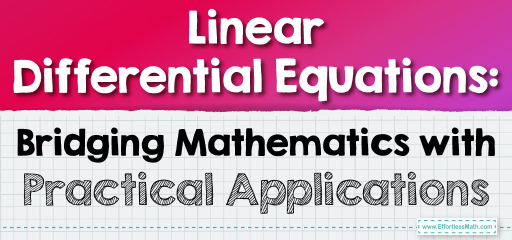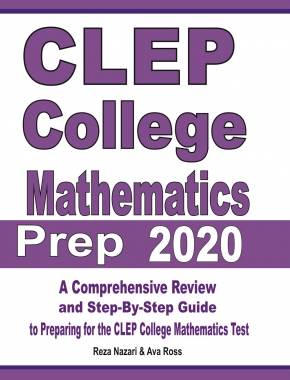Linear Differential Equations: Bridging Mathematics with Practical Applications
Linear differential equations feature a function and its first derivative in a linear relationship, without any powers or products of these terms. They're solved using integrating factors or other specific methods, providing solutions that model phenomena in physics, economics, and other applied sciences effectively.

Linear differential equations can be of higher order. These equations involve not just the first derivative, but also second, third, or higher order derivatives. However, they remain linear in terms of these derivatives and the function itself, without any powers or products of the function and its derivatives. Higher-order linear differential equations are common in physics and engineering, often used to model complex systems like oscillations, wave phenomena, and heat conduction. Solving them typically requires more advanced techniques, such as the method of undetermined coefficients or Laplace transforms.
Categories:
The main types of linear differential equations include:
Ordinary Linear Differential Equations (ODEs): These involve one independent variable and its derivatives. They’re categorized mainly by order (first, second, etc.).
Partial Linear Differential Equations (PDEs): Involving partial derivatives, these equations have more than one independent variable, common in physics for describing phenomena like heat and wave propagation.
Homogeneous Linear Differential Equations: These have no constant or function term independent of the unknown function and its derivatives. They’re characterized by the sum of terms equalling zero.
Non-Homogeneous Linear Differential Equations: These include a non-zero function or constant term. The solutions typically involve finding a particular solution and a complementary function.
Linear Systems of Differential Equations: Involving multiple linear differential equations, these systems are used to model interconnected dynamic systems, like interacting species in an ecosystem.
Each type has distinct characteristics and requires specific methods for finding solutions.
Certainly! Let’s consider an example for each category of linear differential equations mentioned in your overview:
1. Ordinary Linear Differential Equations (ODEs)
- Example: \( \frac{dy}{dx} + y = x \)
- Context: This is a first-order linear ODE. Such equations often model exponential growth or decay, like radioactive decay in physics or interest calculations in finance.
- Solution Method: Can be solved using an integrating factor.
2. Partial Linear Differential Equations (PDEs)
- Example: \( \frac{\partial^2 u}{\partial t^2} = c^2 \frac{\partial^2 u}{\partial x^2} \) (One-dimensional wave equation)
- Context: PDEs like this model wave propagation, heat flow, or diffusion processes.
- Solution Method: Separation of variables or Fourier transform methods are commonly used.
3. Homogeneous Linear Differential Equations
- Example: \( y” + 4y’ + 4y = 0 \)
- Context: Homogeneous linear differential equations are used in mechanical vibrations and electrical circuits without external forcing terms.
- Solution Method: Characteristic equation method is typically employed.
4. Non-Homogeneous Linear Differential Equations
- Example: \( y” + y = \cos(x) \)
- Context: This type of equation could model a damped harmonic oscillator with an external forcing term.
- Solution Method: Solutions can be found using the method of undetermined coefficients or variation of parameters.
5. Linear Systems of Differential Equations
- Example:
\( \begin{align} \frac{dx}{dt} &= 3x + 4y \\ \frac{dy}{dt} &= -4x + 3y \end{align} \) - Context: Systems like this can be used to model predator-prey dynamics in ecology or interconnected electrical circuits.
- Solution Method: Often solved using matrix methods or by converting the system into a higher-order single differential equation.
Related to This Article
More math articles
- How to Solve the Complex Plane?
- How to Add and Subtract Radical Expressions? (+FREE Worksheet!)
- How to Multiply two Binomials Using Algebra Tiles?
- ISEE Upper-Level Math FREE Sample Practice Questions
- How Is the TSI Test Scored?
- ParaPro Math Formulas
- Area of a Trapezoid
- 5 Best AFOQT Math Study Guides
- Geometry Puzzle – Challenge 62
- How to Graph Triangles and Quadrilaterals?


























What people say about "Linear Differential Equations: Bridging Mathematics with Practical Applications - Effortless Math: We Help Students Learn to LOVE Mathematics"?
No one replied yet.